People frequently ask us, “How important is fall protection?” Many contractors and installers have spent so much time on top of metal roofs, they’re confident they can easily navigate the terrain. But accidents may happen. In addition to protecting yourself and your workers, OSHA (the Occupational Safety and Health Administration) established requirements professionals must follow.
As you select the fall protection systems best suited for your job to comply with OSHA regulations, it’s critical to know the company is verified and the system you’re using has been accurately engineered. Today, we’ll cover when fall protection is needed, the major types of fall protection and how to know if your fall protection is truly secure.
When Should You Use Fall Protection?
There are many reasons to access your metal roof. You may be installing ancillaries such solar PV direct-attach systems or attachments for solar panel rails, snow retention systems, HVAC equipment, utilities or satellites. Rooftop inspections, cleaning and maintenance or servicing equipment also take you to rooftop heights. It’s likely all of these activities require fall protection.

When you’re on the roof, how do you know the areas of greatest concern? Five common rooftop hazards can be easily remembered through Diversified Fall Protection's APRON approach outlines five common rooftop hazards you can easily remember. They include access points, the perimeter of the roof, rooftop equipment, openings and navigation. Get expert information on the APRON approach in Professional Roofing magazine.
What Type of Fall Protection Do You Need?
According to OSHA, fall-arrest systems must be designed to prevent a worker from free falling more than six feet or contacting a lower level, such as the ground or a lower roof plane. In many cases, you’ll need guardrails or a personal fall-arrest system, which includes anchors as secure attachments for lifelines. Here’s a closer look at anchors and guardrails.
Anchor Points
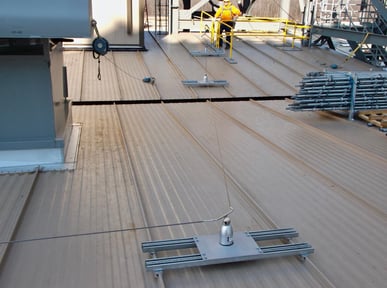 |
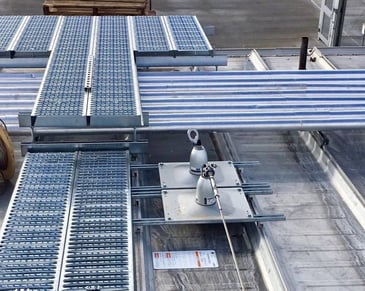 |
|
Horizontal lifeline attached to various anchor points with S-5! clamps and Unistrut (Source: Diversified Fall Protection) |
Walkways and lifeline attached to an anchor point with S-5! clamps and Unistrut (Source: Diversified Fall Protection) |
An anchor point can be a single secure attachment used for a fall-arrest system. In this situation, a body harness is connected to the anchor, limiting the falling distance if you were to descend over an edge. A single anchor can also be paired with travel-restraint lanyards designed to prevent access to the area where a fall hazard occurs. Another option providing more freedom of movement is called a horizontal lifeline. This system includes multiple anchor points and a connected cable. Anchor points can be installed on a temporary or permanent basis, and they require some training for proper use.
For fall-arrest systems, OSHA requires the anchorage strength to be “capable of supporting at least 5,000 pounds per person attached or be designed, installed, and used under the supervision of a qualified person, as part of a complete personal fall arrest system that maintains a safety factor of at least two.”
Fall-restraint (or travel-restraint) systems must be able to “withstand 3,000 pounds or twice the maximum expected force needed to keep the worker from accessing the fall-hazard area.”
Guardrails
-1.jpeg?width=596&height=450&name=Rooftop%20Walkway%20(9)-1.jpeg) |
|
Rooftop walkway and guardrail mounted with S-5! standing seam clamps (Source: Diversified Fall Protection) |
Guardrails are placed around the roof’s perimeter or any unprotected or exposed side to prevent you from falling off the edges. As passive barriers, guardrails don’t require training. When correctly installed, they are extremely reliable. Often permanent fixtures on the roof, guardrails can save you money on the need for repeated professional inspections.
Guardrails used for fall protection must be able to withstand a 200-pound force in any outward or downward direction within two inches of the top edges.
Walkways
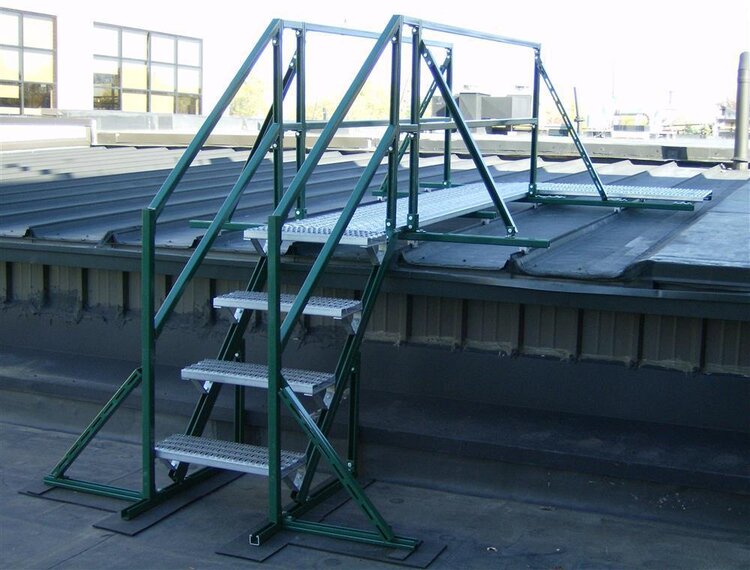 |
|
Rooftop walkway and stairs mounted with S-5! clamps (Source: Diversified Fall Protection) |
In large commercial settings, rooftop walkways are another way to keep your employees safe when you have equipment or systems on the roof that must be maintained. For example, on the Apple Park headquarters building in California, six miles of walkways were installed in conjunction with a 7.4 MW rooftop solar PV array.
How Do You Know Your Fall Protection Is Secure?
Given the weight loads the systems need to carry, you must be confident your attachments can support the anchors, guardrails or walkways in a safe and reliable manner. The only way to ensure this is to utilize attachments properly load tested and include a factor of safety.
The variables involved in metal roofing include profile types, material type, gauges and substrates. Load testing must take all of these factors into account in order to be viable. Each situation is unique, and the way an attachment performs on one type of roof is no guarantee that it will perform the same way on another. For this reason, the vendor(s) must have load tests data on assemblies identical to your specific roof in every detail including material type, gauge thickness, profile and brand of manufacture. In addition, these tests should be conducted through certified, independent third parties, so you know the results are proven accurate.
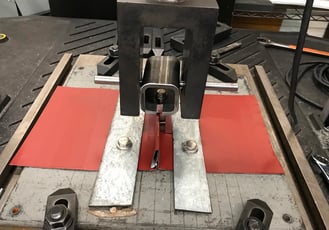 |
|
Load testing of a standing seam metal roof clamp |
When mounting fall protection, you’ll need to be careful not to compromise the integrity of your metal roof. For your standing seam metal roof, select clamps specifically made for your seam profile. Source fall protection systems with clamps produced in an audited facility with quality assurance standards for product consistency. Make sure the clamps are manufactured from corrosion-resistant metals and are metallurgically compatible with your roof material.

To protect your standing seam metal roof from unnecessary holes, choose fall protection systems with non-penetrating clamps that rely on a mechanical interlock for superior holding strength. For permanent fall protection systems, source clamps durable enough to last the life of your roof, backed by a manufacturer’s warranty.
Ideas to Hold Onto
It’s critical to protect yourself and your workers from falling to lower levels while on your metal roof – whether installing ancillaries and equipment or conducting inspection and maintenance. OSHA regulations offer multiple fall-protection strategies to choose from including anchor points, guardrails and walkways.
To ensure your safety measures provide adequate protection and meet OSHA-identified loads, you need clamp attachments that are:
 |
Independently load tested to your specific project parameters. |
 |
Designed to fit the seam profile of your standing seam roof. |
 |
Manufactured in a facility with independent quality assurances. |
 |
Non-penetrating, to protect your roof. |
 |
Corrosion-resistant and long lasting. |
By selecting fall protection systems with tested and proven attachments, you can keep yourself and your workers safe and be truly confident on your metal roof.

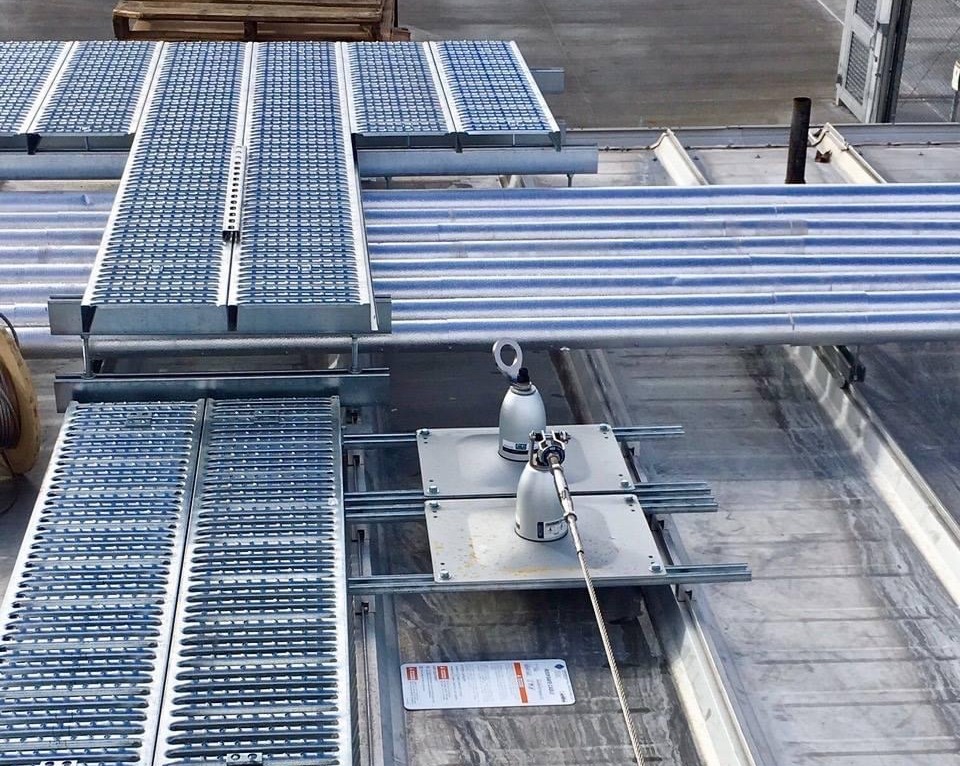

.png?width=267&height=267&name=fall-protection-man@2x%20(1).png)